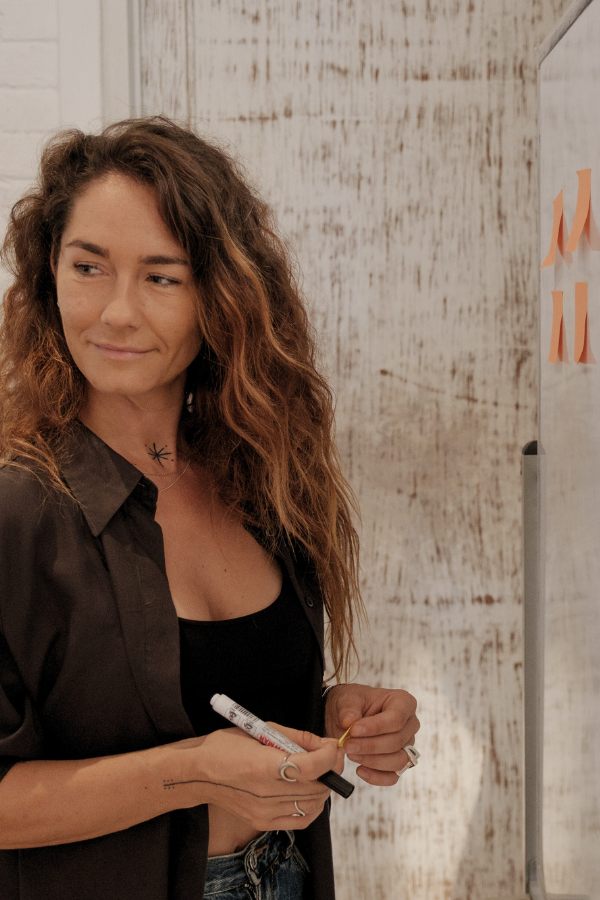

10 Essential Business Tips for First-Time Creative Entrepreneurs
Summary
Starting a creative business is an exciting journey filled with both challenges and opportunities. This article offers 10 essential tips tailored specifically for new creative entrepreneurs, covering everything from defining your vision and embracing imperfection to protecting your creative energy and building a sustainable practice. These tips will help you navigate the complexities of running a business while staying true to your artistic integrity, ultimately leading to a successful and fulfilling venture.
Reflection Questions
- How can I align my creative vision with a clear business mission to guide my decisions and maintain focus?
- What steps can I take to protect my creative energy while balancing the demands of running a business?
- How can I celebrate small wins to stay motivated and maintain momentum on my entrepreneurial journey?
Journal Prompt
Reflect on your creative journey so far and write about the unique aspects of your work that you want to preserve as you grow your business. How can you stay true to your artistic integrity while also making practical decisions that support your business’s success?
Taking your business idea from concept to fully realized venture is exciting, inspiring, and, let’s be honest, packed with a fair share of challenges. As a woman diving into this journey for the first time, you’re likely driven by a deep passion for your craft. However, balancing that creative energy with practical business demands can feel overwhelming. Whether managing finances, understanding legalities, or simply finding time to create, the hurdles are real—but so are the rewards.
This article offers so much more than the generic small business tips you’ll typically see on the web; it’s tailored to your unique path as a creative founder. You already know you need to open a business bank account, conduct market research, write a business plan, and apply for permits; we’re here to help you take your business one step further. Let’s navigate these challenges together so you can sustain a successful business that brings joy, fulfillment, and discovery to your daily life.
10 Tips Every Small Business Owner Should Consider Before Launching Her Creative Venture
Tip 1: Define Your Creative Vision and Business Mission


Many business owners focus so closely on cash flow that they forget why they decided to start a business in the first place! No matter where your company goes, you’ll need a foundation to return to.
When you’re starting a new business, your passion is the spark that gets everything going, but to truly thrive, you need to channel that passion into a clear creative vision and a solid business mission. Think of your creative vision as the “why” behind your work—the driving force that fuels your creativity.
Now, pair that with a business mission, which is your “how” and “what”—the practical steps you’ll take to bring your vision to life and make an impact. When your passion and purpose are aligned, they guide every decision you make, keeping you focused on what truly matters as you grow your business.
Stay True to Your Artistic Integrity


As you navigate the ups and downs of building your own business, it’s crucial to stay true to your artistic integrity. It’s easy to feel pressured to compromise your creative values for the sake of quick wins or to meet market demands, but remember, your unique voice is what sets you apart.
That doesn’t mean you can’t make practical business decisions—sometimes, you might need to adapt or evolve your approach. The key is to do so in a way that honors your core values. Balance is essential; by staying connected to what makes your work meaningful, you’ll build a brand that not only succeeds but also resonates deeply with you and your audience.
Figure Out How to Communicate Your Vision and Mission


Once you’ve defined your creative vision and business mission, it’s important to communicate them clearly and consistently. Whether you’re crafting a brand story, designing your website, or talking to potential clients, let your vision and mission shine through.
This helps attract the right target customers and keeps you grounded in what you’re building. Remember, your business is an extension of your creativity, and sharing your vision with the world is a powerful way to connect with others who appreciate and support your work.
Tip 2: Embrace Imperfection and Iterate


Perfectionism is a common struggle among creative entrepreneurs with small businesses. It’s natural to want every detail of your work to be flawless before sharing it with the world, but this mindset can often lead to paralysis, where nothing gets done because it’s never “good enough.” Remember, waiting for perfection can hold you back from making progress. Instead, recognize that imperfection is a part of the creative process and that it’s better to start and improve along the way than to wait for an unattainable level of perfection.
The beauty of iteration is that it allows you to learn and grow as you go. Rather than aiming for a perfect launch, embrace the idea of starting with what you have, gathering feedback, and making adjustments over time. This approach not only reduces the pressure but also enables you to refine your offerings based on real-world insights. By iterating, small business owners can stay flexible and responsive to their audience’s needs and continuously improve their business.
Tip 3: Build a Sustainable Creative Practice


When your passion becomes your business, it’s easy for that passion to turn into pressure, leading to burnout. To avoid this, it’s essential to establish sustainable routines that support both your creativity and your well-being.
This might mean setting aside regular time for rest, scheduling creative breaks throughout your workday, or practicing self-care rituals that help you recharge. Remember, your creativity is your greatest asset, and nurturing it requires balance.
Balancing Creative Flow with Structure
Finding the right balance between creative flow and structure is key to maintaining consistent productivity. While it’s important to allow yourself the freedom to create without constraints, having some structure in place can help you stay on track with your goals.
Consider creating a flexible schedule that accommodates your creative peaks while also setting aside time for necessary business tasks. This way, you can ensure that your creativity thrives without your business falling by the wayside.
Tip 4: Craft a Story-Driven Brand Identity


Storytelling is a powerful tool that can set your brand apart by creating a deep, emotional connection with your customers. People are drawn to stories—they want to know the “why” behind your brand, the journey that led you to where you are, and what makes your work unique. By weaving your story into your brand, you invite customers to connect with you on a personal level, making your brand more memorable and impactful.
Your personal journey as a founder is a rich source of authenticity and relatability. Don’t be afraid to integrate your experiences, challenges, and triumphs into your brand identity. This not only humanizes your business but also helps potential customers see the real person behind the brand. By sharing your story, you create a brand that is not just about selling a product or service, but about building relationships and fostering trust.
Tip 5: Don’t Be Afraid to Niche Down


It’s natural to worry that by focusing on a niche, you might be limiting your audience. However, niching down is one of the most effective ways to attract your ideal clients—those who truly value and resonate with your work. Instead of trying to appeal to everyone, which can dilute your brand, honing in on a specific niche allows you to position yourself as an expert in that area, making your business stand out in a crowded market.
To find your niche, you’ll need to identify the intersection of your passions, skills, and market demand. Start by reflecting on what you love most about your creative work and who you enjoy working with. Then, research the market to see where there’s a need that aligns with your strengths. Once you’ve identified your niche, commit to it fully—this focus will not only make your marketing efforts more effective but also attract a loyal customer base that appreciates your specialized expertise.
Tip 6: Cultivate a Community Around Your Brand


Your business should be about more than just acquiring customers; it should be about cultivating a community. When you foster a sense of belonging around your brand, you build loyalty and encourage word-of-mouth marketing. A community feels connected to your mission and values, and they’re more likely to support you over the long term. This goes beyond transactions—it’s about creating meaningful relationships with the people who believe in what you do.
Authentic engagement is key to building a thriving community. Share your story, offer behind-the-scenes glimpses of your creative process, and respond to your audience in a genuine way. Whether it’s through social media, newsletters, or in-person events, prioritize building real connections. By showing up as your authentic self, you not only attract people who resonate with your brand but also foster a supportive network that can help your business grow.
Tip 7: Get Comfortable with the Business of Creativity


You started your business because you love what you do—not because you have a traditional business background. But embracing business skills is essential, even if they feel outside your comfort zone.
Understanding concepts like profit margins, cash flow, and marketing strategies is crucial for the sustainability of your business. These skills empower you to make informed decisions, manage your resources wisely, and position your business for growth. Remember, learning the language of business is a process, and it’s okay to seek help along the way.
Fuel your creative fire & be a part of a supportive community that values how you love to live.
subscribe to our newsletter
*please check your Spam folder for the latest DesignDash Magazine issue immediately after subscription


Business Terms to Know Before You Start
- Business License: A legal authorization issued by local, state, or federal government that allows your business to operate within a certain jurisdiction. Depending on your business type and location, you may need multiple licenses or permits, such as health permits, zoning permits, or professional licenses. Failure to obtain the necessary licenses can result in fines, penalties, or even the closure of your business.
- Business Plan: A document outlining your business’s goals, strategies, target market, financial projections, and operational plan. It’s a roadmap for your business and is often required when seeking funding.
- Revenue: The total amount of money your business generates from selling products or services before any expenses are deducted.
- Profit Margin: The percentage of revenue that remains after all expenses (costs of goods sold, operating expenses, taxes, etc.) have been deducted. It’s a key indicator of your business’s financial health.
- Cash Flow: The movement of money in and out of your business. Positive cash flow means more money is coming in than going out, which is crucial for covering expenses and growth.
- Expenses: Costs incurred in the operation of your business. These can be fixed (rent, salaries) or variable (materials, shipping). Understanding and managing expenses is key to maintaining profitability.
- Break-Even Point: The point at which your revenue equals your expenses, meaning you’re not making a profit but not losing money either. It’s important to know when your business will reach this point.
- ROI: A measure of the profitability of an investment. It’s calculated by dividing the profit earned from an investment by the cost of that investment, expressed as a percentage. ROI helps determine whether a particular business decision is worth the cost.
- Equity: The ownership value of your business, calculated as total assets minus total liabilities. Equity represents the value that would be returned to shareholders if all assets were liquidated and all debts paid off.
- Assets: Anything of value that your business owns, such as cash, inventory, property, and equipment. Assets are used to operate and grow your business.
- Liabilities: Debts or obligations that your business owes to others, such as loans, accounts payable, and mortgages. Managing liabilities is crucial to maintaining financial stability.
- Net Income: The amount of money your business earns after all expenses, taxes, and costs have been subtracted from total revenue. It’s often referred to as the “bottom line” and indicates your business’s profitability.
- Operating Costs: The expenses associated with the day-to-day running of your business, including rent, utilities, payroll, and supplies.
- Accounts Receivable: The money owed to your business by customers for goods or professional services delivered but not yet paid for. Managing accounts receivable effectively ensures you maintain a healthy cash flow.
- Accounts Payable: The money your business owes to suppliers or vendors for products or services received but not yet paid for. Keeping track of accounts payable is important for managing cash flow and maintaining good supplier relationships.
- Inventory: The goods or materials your business holds for the purpose of resale. Effective inventory management helps reduce costs and meet customer demand.
- Sales Tax: A tax on sales of goods and services, which your business collects from customers and pays to the government. Understanding your sales tax obligations is important to ensure compliance.
- Gross Margin: The difference between revenue and the cost of goods sold (COGS), divided by revenue, expressed as a percentage. It indicates how well your business is managing its production costs relative to sales.
- Market Research: The process of gathering, analyzing, and interpreting information about your market, including your customers, competitors, and industry trends. It’s essential for making informed business decisions.
- Target Market: The specific group of consumers your business aims to reach with its products or services. Identifying your target market is key to creating effective marketing strategies.
- Branding: The process of creating a unique name, image, and identity for your business in the minds of consumers. Effective branding differentiates your business from competitors and builds customer loyalty.
- Intellectual Property (IP): Creations of the mind, such as inventions, designs, logos, and trademarks, that your business can legally protect. Understanding IP rights is important for safeguarding your business’s unique assets.
- Business Structure: The legal organization of your business, such as a sole proprietorship, partnership, LLC, or corporation. Each structure has different implications for liability, taxes, and ownership.
- Funding/Financing: The process of securing money to start or grow your business. This can include personal savings, loans, grants, crowdfunding, or investment from venture capitalists.
- KPIs (Key Performance Indicators): Metrics that help you measure the success of your business’s operations, such as sales growth, customer retention, and profit margins. KPIs are essential for tracking progress and making data-driven decisions.
- Employer Identification Number (EIN): A unique nine-digit number assigned by the IRS to businesses operating in the United States. It’s essentially the business equivalent of a Social Security number and is used for tax purposes. You’ll need an EIN if you have employees, operate as a corporation or partnership, or if you need to open a business bank account. Obtaining an EIN is a crucial step in legally establishing your business and is required for various business operations, including filing tax returns and applying for business licenses.
- Professional Liability Insurance: Protects your business from claims of negligence, mistakes, or failure to perform professional services. If your business provides advice, services, or expertise to clients, this insurance is essential to protect you against potential lawsuits. For example, if a client believes that your advice led to financial loss or harm, professional liability insurance can cover legal defense costs and any settlements or judgments. It’s especially important for businesses in industries such as consulting, legal services, healthcare, and design.
- Venture Capital: A form of financing provided by investors to startup companies and small businesses that are believed to have long-term growth potential. Venture capital is typically provided in exchange for equity (ownership) in the company. This type of funding is often sought by businesses in the early stages that need significant capital to grow but may not yet be profitable. While venture capital can provide substantial funding and valuable mentorship from experienced investors, it also means giving up some control over your business and sharing profits with investors.
- Commercial Property Insurance: Protects the physical assets of your business, such as your building, equipment, inventory, and furniture, against damage or loss due to events like fire, theft, vandalism, and natural disasters. If you own or lease commercial property, this insurance is essential to safeguard your investment and ensure that your business can recover quickly in the event of a loss. Commercial property insurance can cover the cost of repairs, replacement of damaged property, and even loss of income if your business operations are interrupted due to a covered event.
Understanding Legal Implications and Business Structures


Navigating the legal aspects of running a business is just as important as mastering the creative side. Choosing the right business structure—whether it’s a sole proprietorship, LLC (Limited Liability Company), or corporation—can have significant implications for your taxes, liability, and growth potential. If you choose the wrong structure, you might struggle to geet a small business loan or hire employees.
Understanding contracts, intellectual property, and liability protection is crucial to safeguarding your business. It’s worth investing in professional legal advice to ensure your business is compliant and protected from potential legal issues. You might also need general liability insurance, so look into that, too!
Finding Resources and Mentors


You don’t have to go it alone—there are plenty of resources and mentors available to help bridge the gap between creativity and business acumen. Look for courses, workshops, and online communities where you can learn the essentials of running a business.
Seek out mentors who have been through the entrepreneurial journey and can offer guidance and support. Building a network of resources and mentors can provide you with the knowledge and confidence you need to succeed.
Tip 8: Bootstrap Wisely and Creatively


When starting out, managing finances creatively is often necessary. Look for ways to stretch your budget, such as bartering services with other creatives, utilizing DIY marketing techniques, and leveraging free or low-cost tools.
Prioritize spending on the essentials that will have the most significant impact on your business, and be resourceful in finding ways to achieve your goals without overspending. Every dollar counts, so make sure your budget aligns with your business priorities.
Exploring Funding Opportunities


While bootstrapping is a common approach, it’s important to know that there are other ways to finance your business without solely relying on personal savings. Explore funding options such as small business loans, grants specifically for women entrepreneurs, crowdfunding platforms, and angel investors.
Research each option carefully to find the one that best aligns with your business goals and values. Having access to additional funding can provide the resources you need to grow your business more quickly and sustainably.
Investing in What Matters
Investing wisely is about choosing where to put your resources for the greatest return. Focus on areas that will directly contribute to your business’s growth like high-quality tools, professional branding, or expert advice.
These investments can make a significant difference in the long-term success of your business. Avoid unnecessary spending, and prioritize what truly matters—this strategic approach ensures that every dollar you invest is helping to build a strong foundation for your business.
Tip 9: Protect Your Creative Energy


As a creative entrepreneur, it’s important to manage external pressures—whether they come from clients, market trends, or the demands of running a business—without compromising your creative energy. Set clear expectations with clients, prioritize projects that align with your vision, and stay true to your creative process. By managing these pressures effectively, you can protect the creative spark that drives your work and ensures your business remains a reflection of your unique talents.
Set Boundaries
Setting boundaries is essential for protecting your time, creativity, and mental well-being. Whether it’s defining your work hours, saying no to projects that don’t align with your values, or taking time off to recharge, boundaries help you maintain balance. By being clear about what you need to stay healthy and inspired, you can prevent burnout and keep your creative energy flowing. Remember, setting boundaries isn’t about being rigid—it’s about ensuring that you have the space to do your best work.
Tip 10: Celebrate Small Wins and Keep Going


In the fast-paced world of entrepreneurship, it’s easy to focus on what’s next and forget to celebrate the milestones you’ve already achieved. Taking the time to acknowledge small wins—whether it’s completing a project, reaching a sales goal, or simply getting through a tough week—helps you stay motivated and appreciate the progress you’re making. These moments of celebration are vital for maintaining momentum and reminding yourself of how far you’ve come.
The entrepreneurial journey is filled with ups and downs, and resilience is key to navigating the challenges that come your way. Setbacks are inevitable, but they don’t define your success—how you respond to them does. Embrace the lessons that come from challenges, and keep moving forward with persistence and determination. Remember, every setback is an opportunity to learn and grow, and with resilience, you can overcome obstacles and continue building the business of your dreams.
Final Thoughts on Starting Your Brand New Creative Business (We Believe in You!)


Starting a creative business is an incredible journey filled with both challenges and opportunities. We encourage you to dive in, take action, and trust that you have what it takes to succeed. At the end of the day, building your business isn’t just about making money; it’s about bringing your unique talents to the world and making a lasting impact. Keep pushing forward, stay true to your passion, and watch your dreams come to life.








